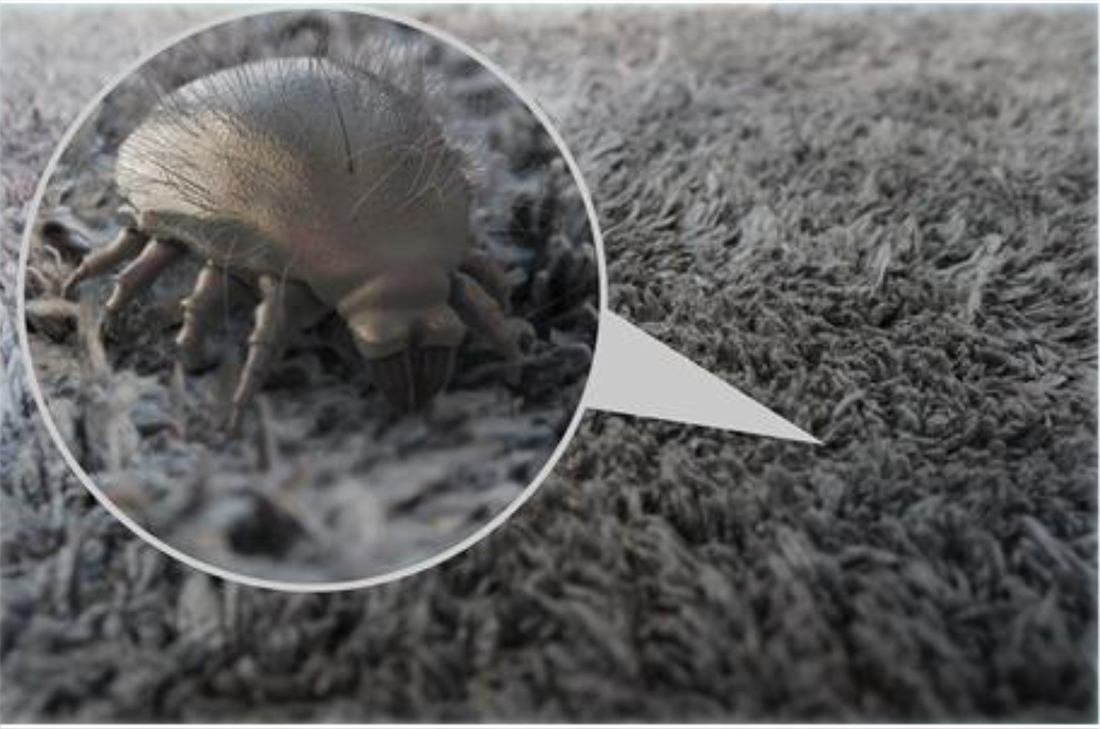Patient information on House Dust Mite Allergy
Who is this information for?
This information is for children and adults with dust mite allergy.
What are house dust mites?
Dust mites are a microscopic type of insect that lives in bedding, sofas, curtains, carpets or any woven material.
Dust mites do not bite and do not cause harm to humans, other than by triggering allergie.
Mites absorb humidity from the atmosphere (i.e. they do not drink), and feed on organic matter (including shed human and animal skin).
Mites absorb humidity from the atmosphere (i.e. theydo not drink), and feed on organic matter (including shed human and animal skin).
They require sufficient humidity and nests to live in (which are not visible to the naked eye).

What is house dust mite allergy?
An allergy to dust mites may result in a condition called allergic rhinitis (refer to Allergic Rhinitispatient information sheet).
Patients with asthma may find their asthma is exacerbated as a result of a dust mite allergy. Symptoms are usually persistent and present throughout the year.
What treatment options are available to manage dust mite allergy?
Treatment options available to manage allergic rhinitis include:
- Aeroallergen avoidance / minimisation
- Medications
- Allergen specific immunotherapy
What are the aeroallergen avoidance strategies to manage dust mite allergy?
- Encase pillows,mattresses, doonas, blankets, and furniturein mite-impermeable protective coverings to reduce dust mite infiltration.
- Tightly woven fabrics with a pore size of ≤6 microns are very effective at controlling the passage of mite.
- Remove or reduce curtains (especially horizontal blinds) and soft furnishings in bedrooms
- Replace carpet with linoleum or floor boards which can be wiped clean
- Replace fabric covered seatingwith leather or vinyl
- Remove soft toys from the bedroom
- Do not allow pets in the bedroom
- Washing bedding every 1-2 weeks at 55-60°C to kill dust mites
- Use a vacuum cleaner with a HEPA filter if possible
- Dampen dust when dusting or cleaning surfaces
- Dust mites do not have natural protection against sunlight, so exposing mattresses, rugs and carpet to sunlight for more than 3 hours can kill mites
- Indoor humidity levels should be kept between 30-50% (inexpensive humidity monitors can be purchased at most hardware stores)
- Humidifiers make the problem worse and are not recommended.
- N.B. Despite the above advice, studies are yet to show that physical or chemical cleaning methods reduce dust mite levels to a degree that improves symptoms.
What medications are available to manage dust mite allergy?
- Antihistamines (tablets/nasal spray): effective in managing histamine-related symptoms such as itching, watery nose/eyes and sneezing. This medication is not helpful for nasal blockage.
- Nasal steroid spray/drops: often used as first line management in children aged over 2 and adults, mainly to treat nasal congestion or blockage.
- Nasal irrigation: washing out the nasal cavity has been shown to reduce the amount of allergens in the nose (see MEG nasal irrigation information pamphlet)
Is allergen specific immunotherapy available for dust mite allergy?
- Allergen specific immunotherapy is available for dust mite allergy in severe cases.
- It involves exposure to a small amount of the allergen in order to induce tolerance.
- Specific immunotherapy is the only treatment which modifies the immune response to allergens rather than just treating the symptoms.
- For house dust mites it can be administered as
- Sub-cutaneous immunotherapy (SCIT): Under the skin, via small injections.
- A typical treatment may require monthly injections over 3-5 years.
- Sub-lingual immunotherapy (SLIT): Under your tongue, via small dissolvable tablets.
- A typical treatment may require giving the allergen sublingually (under the tongue) on a daily basis for 2-3 years.
- E.g. Acarizax®or Actair®
- Sub-cutaneous immunotherapy (SCIT): Under the skin, via small injections.
- Immunotherapy is usually only considered in older children and adults when symptoms are not well controlled with other measures
Concerns or questions?
You can contact your ENT Specialist at the Melbourne ENT Group (MEG):
- Phone: 1300- 952-808
- Email: admin@melbentgroup.com.au
- Website: www.melbentgroup.com.au
Assessment by Orthodontist, dentist of Oral Maxillo-facial Surgeon is also recommended.
Your GP is also the best contact for ongoing care and concerns.